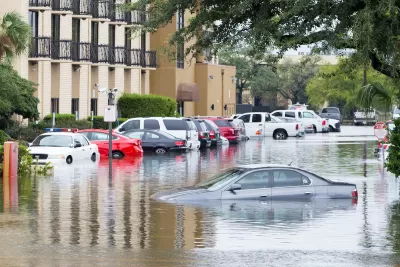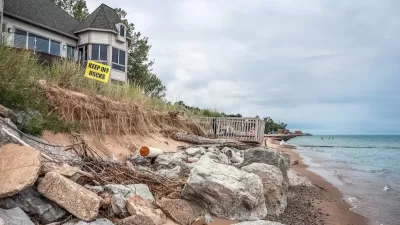Regions at high risk for flooding, wildfires, and other climate-fueled disasters continue to see rapid population growth.

Americans are moving to regions at high risk of climate-related disasters, putting more people in the path of dangerous hurricanes, wildfires, and other climate crises, reports Aimee Picchi for CBS News.
This is despite spiking insurance costs — and the refusal of some insurers to cover homeowners in certain states, such as Florida and California, altogether. A 2023 report found that over 3 million Americans have moved to new areas due to growing flood risks and prohibitively high insurance rates. “The average annual premium for a Florida homeowner is $5,500 — about 140% higher than the typical U.S. homeowner's cost of $2,285, according to Bankrate.”
However, “The populations of high-risk counties have grown at a rate that's 3 percentage points faster than low-risk counties over the last three decades, according to research from economists Agustin Indaco, Francesc Ortega and Xinle Pang.” In the West, where wildfires are growing larger and more destructive, is also seeing outsized population growth as people newly untethered from office jobs seek more affordable housing options.
According to a recent study, the bulk of migration, as well as development in flood-prone areas, is mainly concentrated in Florida and Louisiana, as well as other parts of the Gulf Coast.
FULL STORY: Americans are flocking to U.S. regions most threatened by climate change

Alabama: Trump Terminates Settlements for Black Communities Harmed By Raw Sewage
Trump deemed the landmark civil rights agreement “illegal DEI and environmental justice policy.”

Planetizen Federal Action Tracker
A weekly monitor of how Trump’s orders and actions are impacting planners and planning in America.

Why Should We Subsidize Public Transportation?
Many public transit agencies face financial stress due to rising costs, declining fare revenue, and declining subsidies. Transit advocates must provide a strong business case for increasing public transit funding.

Understanding Road Diets
An explainer from Momentum highlights the advantages of reducing vehicle lanes in favor of more bike, transit, and pedestrian infrastructure.

New California Law Regulates Warehouse Pollution
A new law tightens building and emissions regulations for large distribution warehouses to mitigate air pollution and traffic in surrounding communities.

Phoenix Announces Opening Date for Light Rail Extension
The South Central extension will connect South Phoenix to downtown and other major hubs starting on June 7.
Urban Design for Planners 1: Software Tools
This six-course series explores essential urban design concepts using open source software and equips planners with the tools they need to participate fully in the urban design process.
Planning for Universal Design
Learn the tools for implementing Universal Design in planning regulations.
Caltrans
Smith Gee Studio
Institute for Housing and Urban Development Studies (IHS)
City of Grandview
Harvard GSD Executive Education
Toledo-Lucas County Plan Commissions
Salt Lake City
NYU Wagner Graduate School of Public Service





























